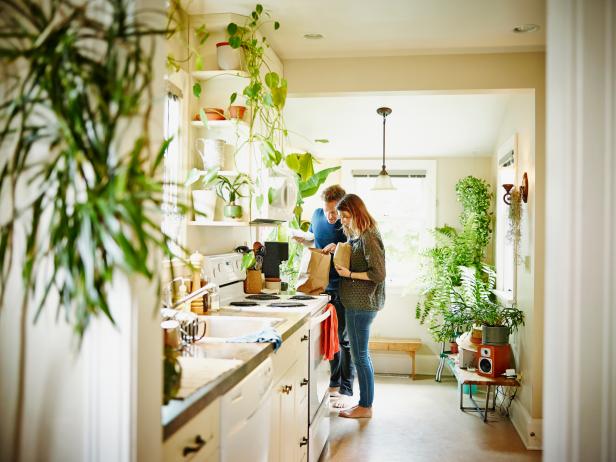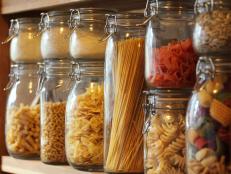How to Cook for Someone Who Depends on You Without Stressing
Deep breathing, smart cooking.

MoMo Productions/Getty
From Leah Brickley for Food Network Kitchen
Some might say the secret to happiness is helping others, but when someone depends on you for their meals, cooking can feel more like a job than a rewarding act of kindness. It’s not uncommon to be responsible for another person’s food, so you’re not alone. You may even have several people relying on you and of different ages and abilities: kids that want chicken fingers and endless snacks and older relatives with special dietary restrictions — it’s a lot to juggle. Take a moment (and a deep breath) and make a sustainable plan that will feed everyone (including yourself!).
Who Are You Cooking For?
What you make depends on who you are feeding. Whether you’re cooking for a baby or an eldery relative there are some important questions to ask before scrolling through recipes.
Are there food allergies? The USDA recognizes the major 8 food allergies as milk, eggs, fish, shellfish, tree nuts, peanuts, wheat and soybeans (with sesame soon to be added). Be sure to ask if anyone has a food allergy (even if it’s not one of the major ones). Consult with a pediatrician for babies beginning on solid foods.
Are there food sensitivities and/or aversions? There are common foods that can cause distress — like dairy for those who are lactose intolerant — be sure to ask if someone is sensitive to a food and what foods they won’t eat.
Are there possible food and medication interactions? Go over any medications the person you’re cooking for takes and be sure there are no food and drug interaction issues. Consult a doctor or pharmacist if you aren’t sure.
Is food texture important? Consistency and thickness of some foods are important to consider when you’re feeding someone with sensitive teeth (or no teeth) or swallowing issues. Ask a nutritionist or a doctor if you have any questions.
Are there favorite foods? This is the fun question! What do they love to eat or are willing to try? Lean in heavy with the foods that make them happy.

Thomas Barwick/Getty
Create a Wellness Kitchen For Yourself
Equip yourself with a zen zone.
Bring in the green: Indoor plants can help reduce stress and anxiety, so add good fauna vibes with something like a succulent, fern or aloe vera plant — all dependent on what kind of light your kitchen gets.
Surround sound: Broadcast your favorite playlist or podcasts while you cook. No one said you can’t entertain yourself. A waterproof, bluetooth speaker is ideal for the kitchen.
Happy feet: Whether you cook in comfy shoes or barefoot your feet will eventually tire. A cushioned kitchen mat is essential to combat foot fatigue.
Apron up: Protect your clothes and get into the mindset of cooking with a professional or fun apron.
Make a Plan
Try to stay as organized (but it’s totally fine to wing it too).
Write a menu and shopping list: Consider your menu as your map, it will help create your shopping list and determine how much time everything will take to prep and cook. If your lists are overwhelming then scale back on your original plan.
Shop smart: Save time by using a click-and-collect or delivery service from your local grocery store.
Set aside time to prep and cook: Block out a chunk of time (or several) during the week dedicated just to prepping and cooking as much as you feel comfortable with.
Get help with the dishes: It could be one of your kid’s chores or even the person you’re cooking for — if they’re able — then ask for assistance with clean-up so you can concentrate on cooking.

Matt Armendariz, Copyright 2015
Take the Stress Out of Cooking
Feed people without losing your mind.
Make breakfast grab-and-go: Even if the person you’re feeding isn’t in a rush — you are! Breakfast foods can be made ahead or try a few convenience items — here are some that are actually healthy.
Stay on top of snacks: Stock the fridge with hard-boiled eggs, chunks of cheese and cut-up fresh fruit. And keep a fruit bowl filled on the counter and snack mix in the pantry.
Rely on leftovers for lunch: Turn last night’s dinner into tomorrow’s lunch. Add a few fresh elements like cut-up veggies and fruit and lunch is done.
Look for quick weeknight meals: Don’t attempt to make dinners that are too complicated, check out some of our best family-friendly weeknight recipes that are quick and easy.
Prepare food you can stretch: Eat something more than once and in multiple dishes: here are our tips for stretching a chicken and other proteins. This will save time and money.
Fill the freezer: Make big batches of food like turkey chili or calzones and have peace of mind knowing your freezer is filled with meals.
Use your slow cooker: Find a permanent spot on the counter for your slow cooker, set it and forget it for everything from carnitas to ribs.
Start a soup swap: Organize a soup exchange with some friends and family: everyone makes a quart of soup for each person in the group, so if you have 6 people you’ll end up with 6 quarts of soup you can freeze and then thaw and heat for an easy meal. Use the same concept for a cookie or recipe swap.
Buy some convenience items: Rely on store-bought, prepared ingredients to help carry some of the load: find soups, microwavable grains and frozen vegetable sides that you like.
Order takeout or delivery: Have at least one cookless meal a week — maybe it’s taco Tuesdays or pizza on Fridays — you’ll be thankful to have someone else do the cooking.
Ask for Help
Finally, it’s OK to ask a family member or friend if they can make a casserole or an extra batch of tomato sauce for you each week. It takes a village and sometimes there can never be too many cooks in the kitchen.
Related Links:































































